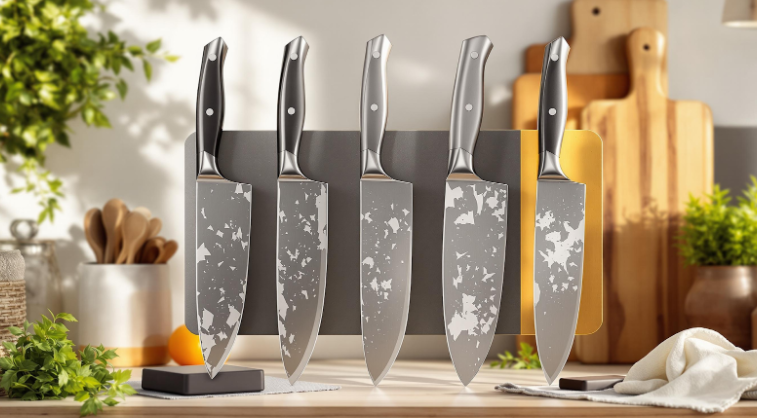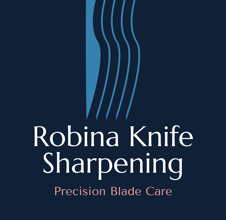Robina Knife Sharpening Book in for same-day service 0466 156 237 4 TIFFANY CLOSE. ROBINA


5 Common Knife Damage Issues and Their Solutions
Kitchen knives are essential tools, but they often face wear and tear. Here's how to fix and prevent five common knife issues:
Chipped edges: Fix with a honing rod, whetstone, or professional service (from AU$20). Prevent by using wooden/plastic boards and avoiding bones or frozen foods.
Bent tips: Straighten with a brass hammer or heat treatment. Store knives properly to avoid pressure.
Dull blades: Sharpen with a whetstone or professional service (from AU$20). Hone regularly and avoid hard surfaces like glass cutting boards.
Rust spots: Remove with vinegar or a potato. Prevent by drying knives immediately and storing them in a dry place.
Loose handles: Repair with oils or glue. Avoid soaking knives and oil wooden handles annually.
Quick Care Tips:
Wash by hand and dry immediately.
Use proper storage (magnetic strips or knife blocks).
Hone weekly and sharpen professionally when needed.
Taking care of your knives ensures they stay sharp, safe, and long-lasting.
1. Fixing Chipped Knife Edges
Why Knife Edges Chip
Chipped knife edges are small nicks that dull your blade, often caused by everyday kitchen habits that unknowingly damage your knives.
Thin Japanese knives are especially prone to chipping due to their smaller sharpening angle and harder steel [2]. While these features create incredibly sharp edges, they also make the blades more fragile.
Here are some common causes of chipped edges:
Using glass or stone cutting boards instead of wood or plastic
Cutting frozen foods that haven't thawed completely
Chopping bones with knives not designed for heavy-duty tasks
Opening packaging or tins with kitchen knives
Scraping food off cutting boards using the blade's edge
How to Fix Chipped Edges
The way to fix a chipped knife depends on how severe the damage is:
Light Damage
If the edge is slightly bent rather than chipped, a ceramic honing rod can help realign it. This method is quick and straightforward.Moderate Chips
For small chips, use a coarse whetstone or diamond plate to grind away the damaged steel and form a new edge. This requires patience and proper technique.Severe Damage
If the chip is large or you’re hesitant about repairing it yourself, professional services can help. For example, Robina Knife Sharpening offers chip removal as part of their sharpening service, starting at AU$20 per knife.
Preventing Edge Chips
The best way to avoid chipped knives is by handling them with care. David Olkovetsky from Artisan Revere advises, "With a thin, sharp knife, use less force" [1]. Following this advice can significantly reduce the risk of damage.
Here are some tips to keep your knife edges intact:
Stick to wooden or plastic cutting boards
Keep your knives sharp to minimise cutting force
Fully defrost foods before slicing
Use the knife's spine to scrape food, not the cutting edge
Store knives in protective covers or on magnetic strips
Use a dedicated cleaver for cutting bones or other tough materials
Even with proper care, small chips may still happen, especially with thin, sharp blades. Regular maintenance and mindful use will help your knives last longer and perform better.
2. Repairing Bent Knife Tips
Why Tips Get Bent
Knife tips can bend for a variety of reasons. Dropping a knife on a hard surface, storing it improperly with the tip pressing against other objects, or using it to pry open containers are common culprits. Applying too much sideways pressure during cutting can also cause this issue. Keeping your knife in good condition reduces the likelihood of bending.
How to Fix Bent Tips
Here are two methods to straighten a bent knife tip:
Brass Hammer Method
For small bends, place the knife on a flat surface and gently tap the bent tip with a brass hammer. Brass is soft enough to limit further damage to the blade [3].Heat Treatment Method
For more severe bends, heat two steel plates to 200–230°C (400–450°F), sandwich the knife between them, clamp it securely, and allow it to cool naturally. This method helps reshape the tip effectively [3].
If the damage is extensive, consider professional services. Robina Knife Sharpening offers repairs, including tip restoration and reshaping, starting at AU$25.
Proper Tip Care
Preventing bent tips is easier than repairing them. Follow these tips:
Store knives on a wooden magnetic strip, in a leather pouch, or in a knife roll.
Hand wash knives with warm, soapy water instead of using a dishwasher.
Schedule professional sharpening at least once a year.
Ensure knives have enough clearance during storage to prevent the tips from touching other blades or surfaces.
With regular care and proper storage, your knives will stay in great shape and last much longer. A little extra attention can go a long way in maintaining their performance.
3. Sharpening Dull Knives
Why Do Blades Become Dull?
A dull knife isn't just frustrating - it can also be unsafe. Everyday habits can quickly wear down a knife's edge. For example, using knives on hard surfaces like ceramic, glass, or stone can blunt the blade. Other common culprits include:
Dishwasher use: Harsh detergents and water pressure can damage the edge.
Improper storage: Tossing knives loosely into drawers can dull and nick the blade.
Wrong tool for the job: Using a chef's knife to cut through bones or other tough materials.
Skipping honing: Failing to hone regularly can cause the edge to roll over time.
If your knife is losing its sharpness, it’s time to bring it back to life.
How to Sharpen Your Knives
When your blade starts to dull, sharpening is essential. Professional services are a reliable way to restore your knife’s edge. For example, Robina Knife Sharpening uses specialised wet grinding equipment with abrasive wheels made of synthetic stone. These wheels operate at low RPM and are cooled with water to protect the blade’s integrity while restoring its sharpness.
For day-to-day upkeep, a honing steel is your best friend. Regular honing helps realign the edge and keeps it performing well between professional sharpenings. Not sure if your knife needs sharpening? Hold it under bright light - if you see a shiny line along the edge, it’s time to sharpen [4].
Tips for Maintaining Sharp Blades
To keep your knives in top condition, follow these simple steps:
Wash them by hand with warm, soapy water.
Dry them immediately to prevent rust.
Store them safely on a magnetic strip or in a knife block to avoid unnecessary wear.
Taking care of your knives ensures they stay sharp and ready for any task.
4. Removing Knife Rust
What Causes Rust?
Even stainless steel knives can rust when iron and oxygen come into contact with moisture. Here are some common causes:
High humidity: Moist air can lead to rust spots on the blade.
Improper cleaning: Leaving knives in the sink or dishwasher exposes them to too much moisture.
Poor storage: Storing wet knives on metal surfaces or magnetic strips encourages rust.
Chemical exposure: Chlorine in some detergents can damage the blade's protective layer.
Rust often forms near the cutting edge due to tiny scratches, making it more prone to corrosion [5]. This not only affects the knife's look but can also impact food safety and cutting performance. Knowing these causes can help you prevent rust from forming in the first place.
How to Remove Rust
If rust has already appeared, here’s how to get rid of it:
Potato Trick
Cut a potato in half and rub it along the blade. For tougher rust spots, leave the knife embedded in the potato for a few hours. Afterward, rinse and dry it thoroughly [6].Vinegar Solution
Submerge the blade in warm white vinegar for up to five minutes. Add a pinch of salt to create a mild abrasive. Once you see the reaction, wipe the blade clean with a soft cloth [6].
Once the rust is gone, it’s time to focus on keeping it from coming back.
Preventing Rust
Keeping knives rust-free is all about proper care:
Dry promptly: Hand-wash knives and dry them completely right away.
Store correctly: Use a wooden knife block, blade guards, or another dry storage solution.
Maintain regularly: Apply a thin coat of food-grade mineral oil to protect the blade.
Avoid soaking: Never leave knives soaking in water or put them in the dishwasher.
For severe rust damage, professional restoration can bring your knife back to life. With regular care, you can keep your knives in great shape and rust-free for years to come.
5. Fixing Loose Knife Handles
Why Handles Loosen
Loose knife handles can be a safety hazard, often caused by changes in temperature and moisture exposure. Wood handles, in particular, can expand and contract with seasonal temperature shifts [8]. Dishwashing or soaking knives can also damage handles, as water and detergents can deform the material [7]. Neglecting regular maintenance may lead to the wood drying out and shrinking away from the tang. While stabilised wood is less prone to these issues, non-stabilised hardwood is more susceptible.
Here’s how you can fix loose knife handles and keep them in good condition.
Handle Repair Methods
The right repair approach depends on the severity of the damage and the type of handle material.
For minor gaps:
Apply food-grade mineral oil to rehydrate and expand the wood.
Use thin CA glue to fill small spaces.
For more severe loosening:
Remove any old adhesive residue.
Apply boiled linseed oil along the wood grain.
For wooden handles, use thin layers of Tru-Oil, allowing proper drying time between coats.
If the knife is valuable, consider professional repair services.
Handle Care Tips
Proper care can prevent future handle issues. Here are some tips:
Oil wooden handles annually to maintain hydration [9].
Store knives in a cool, dry place, away from sunlight.
Always clean and dry knives thoroughly after each use.
Recommended oils include:
Danish oil
Raw linseed oil
Food-grade mineral oil
Walnut oil [8].
Avoid these common mistakes:
Never clean knives in a dishwasher.
Don’t expose handles to prolonged water contact.
Avoid using olive oil, as it can turn rancid over time [8].
Keep knives out of humid storage environments.
Conclusion: Long-Term Knife Care
Taking care of your knives involves a mix of everyday upkeep and occasional professional sharpening. This not only keeps your knives in great shape but also ensures safer and more efficient cooking.
Everyday Maintenance
Wash knives by hand using warm, soapy water right after use. Avoid abrasive scrubbers and make sure to dry them completely before putting them away [10].
Both daily upkeep and professional sharpening work together to maintain your knives' quality.
Keeping the Edge Sharp
Honing helps keep the blade aligned between professional sharpenings, extending its performance [10].
"It's hard to make good food without a good knife...if you don't take care of it, the quality and price won't matter" [11].
Looking after your knives is cheaper than constantly replacing them. With consistent care and occasional professional sharpening, a quality knife can serve you well for years, whether you're cooking at home or in a professional kitchen.
5 common knife damage issues and their solutions
Learn how to fix and prevent common knife damage issues to keep your kitchen tools sharp, safe, and long-lasting.
4/21/20257 min read
Contact
© 2025. All rights reserved.
4 Tiffany Close
Robina 4226

